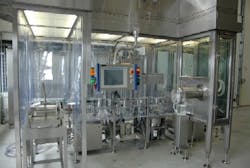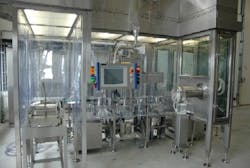Over the last few years the term advanced has been applied to a number of aseptic manufacturing technologies. The 2002 open conference on sterile products co-sponsored by USP and PDA made advanced aseptic processing a discussion point, representing, we believe, the first such discussion in a public forum. At that time, only two advanced aseptic technologies were discussed: isolators and blow-fill-seal. Recently, an advanced technology that fills product into a sealed sterile container has been introduced, and restricted access barrier systems (RABS) have been termed advanced aseptic technology.
We believe that industry and the regulatory community should use the term advanced very conservatively in conjunction with aseptic processing, if it is not to become a commercial catch phrase. Performance limitations must be considered carefully. To avoid further hyperbole and misunderstanding, we propose the following definition:
The following examples would fit this definition:
- Isolators, since they are effectively sealed against the entry of external contamination by means of air over-pressure. Isolators also allow decontamination to be performed in a quantifiable manner, and use gloves or half-suits to separate the human operator and the environment. Finally, all transfers of materials are done through RTPs, decontamination tunnels or pass-throughs.
- Blow-fill-seal systems, provided that direct human interventions are not required during the filling/sealing process.
- Closed-vial filling systems, provided there are no interventions into the critical zone where the filling needle(s) and post-irradiated closure surfaces are exposed prior to filling.
The common theme in these examples is that no direct human interventions are allowed at any time.
Critical distinctions
One could argue that it is possible to have human interventions in isolators, and in many isolator designs this is true. However, isolators are true separative enclosures with no direct entry by human operators wearing conventional cleanroom garments. All interventions are, instead, made through decontaminated gloves and sleeves or half-suits.Under no circumstances should an isolator enclosure be opened and a gowned operator allowed to work directly within the critical zone.
We believe that this distinction is critical, because studies have shown that gowned operators even when using the best garments and technique may release several thousand colony-forming units into the surrounding environment during each hour of work [1, 2]. Any technology that allows this level of interventional activity, and the potential for contamination associated with it, is too risky to be considered advanced.
Closed-vial filling systems, such as this one by Aseptic Technologies (Les Isnes, Belgium), offer distinct advantages as long as they do not require operator intervention. The line features two main areas. On the left is the loading station, protected by laminar air flow. At right is a Restricted Access Barrier System, in which filling occurs. For filling, a needle pierces the stopper, which is then resealed by means of a laser.
Some blow-fill-seal systems require that operators clear plastic that has solidified on fill nozzles, thereby blocking liquid flow. In this case, blow-fill-seal could only be classified as an advanced technology if, after this type of intervention, the product contact equipment was re-sterilized in place and any potentially affected product segregated and destroyed. Once again, the requirement is clear: if direct human intervention with sterile components or product contact surfaces is allowed, without the ability to eliminate any risk from that intervention, the aseptic process cannot be considered advanced.
Sealed sterilized container systems are advanced, as long as they do not rely upon gowned operators. Obviously, the exterior of the seals must be kept sterile and the filling needles must not be contaminated. For these conditions to exist, neither the seals nor the filling needles can be affected by gowned operator intervention. Closed systems offer significant potential advantages for controlling contamination, particularly those that can be penetrated, filled and resealed without operator intervention.
The question of RABS
Somewhat controversial are RABS, a type of aseptic processing that has lately garnered significant interest. We are encouraged by efforts to provide a suitable working definition of these systems; however, we believe that many, if not most, RABS processes would not meet our proposed definition for advanced aseptic processes. In some RABS designs, operators could open the RABS enclosure if an intervention that could not be conducted through the glove ports were required. In such a case, disinfection using a sporicidal agent has been recommended following the intervention. However, even though this treatment would decontaminate surfaces, it would not address the principal route of contamination, which is personnel-generated and dispersed in the environment.
We are also concerned that such a critical intervention as disinfection by gowned operators could raise nearly as many issues as it endeavors to address. Obviously, residuals from this disinfection procedure and contamination from the personnel performing it would be important concerns. It is not clear to what extent a major line clearance might be required, and what subsequent interventions might be required to restore the system to operation.
Clearly, aseptic systems that use gray- or black-side maintenance come closer to the spirit of advanced aseptic processing: systems that eliminate direct intervention by gowned operators.
Some advocates have supported RABS as a more flexible and more cost-effective aseptic processing solution than isolators. We agree that such a solution is more flexible. However, we are not sure that RABS qualifies as a truly advanced solution, and we are not convinced that the technology would result in meaningful cost savings over time.
We fail to see how validation requirements for RABS systems could be reduced relative to those for isolators. In fact, should two distinct types of disinfection be required, the validation workload could not be less than with isolator systems, particularly when a conventional cleanroom background is required, with all that entails in terms of monitoring and process control.
Regulatory relief for advanced systems?
In summary, we believe the standard for advanced aseptic processing must be rigorous and reducible to one principle: no direct interventions by gowned operators at any time.
Systems that meet this definition are currently available, and they should be given some relief from conventional aseptic processing validation requirements. We suggest that quantitative risk analysis be recognized in lieu of traditional validation exercises when advanced technology is employed in aseptic processing. Because these systems minimize the risk from human contamination, requirements for monitoring their environments can and should be substantially reduced.
In the future, we will see even more advanced forms of aseptic processing that address the few residual risks that may exist in current advanced systems. Gloveless isolators are already in use in some aseptic processing systems within the food industry and it is not hard to imagine closed sterile container systems capable of operating in a gloveless, unmanned environment. Automation and robotics may enable engineers to create systems that operate in a fully unmanned environment either with or without an isolator enclosure.The key to advancement lies in the elimination not the tolerance of interventions.
References
1. Reinmüller, B. Dispersion and Risk Assessment of Airborne Contaminants in Pharmaceutical Cleanrooms. Royal Institute of Technology, Building Services Engineering, Bulletin 56, 2001
2. Whyte, W. Reduction of Microbial Dispersion by Clothing, Journal of Parenteral Science and Technology, Vol. 39, No. 1, 1985, pp. 51-60
About the Authors
James Agalloco, BSChE, MSChE, MBA, is president of Agalloco & Associates, a technical service firm to the pharmaceutical and biotechnology industry. He is a past president of the Parenteral Drug Association and served as an officer or director from 1982 to 1993.
Dr. Jim Akers is president of Akers Kennedy and Associates, a technical consulting firm based in Kansas City, Mo. Dr. Akers is a past president of PDA and has served on numerous task forces related to aseptic processing over the years. He is currently chairman of the USP Committee of Experts for Microbiology and Sterility Assurance.
Russ Madsen is president of The Williamsburg Group, LLC, Gaithersburg, Md., engaged in pharmaceutical consulting in CGMP compliance and auditing, quality systems, design review, aseptic processing and sterilization technology, and other areas. He has served as acting president of the Parenteral Drug Association and was senior VP Science and Technology. Before joining PDA, he was director, Technical Services for Bristol-Myers Squibb Co.

